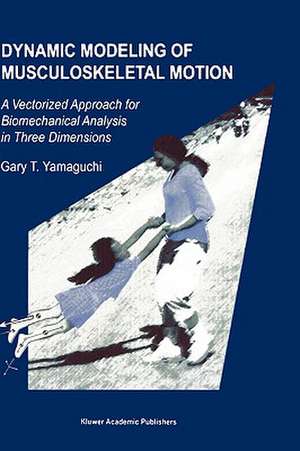Dynamic Modeling of Musculoskeletal Motion: A Vectorized Approach for Biomechanical Analysis in Three Dimensions
Autor Gary T. Yamaguchien Limba Engleză Hardback – 30 iul 2001
Kane's Method builds upon the foundation of vector kinematics and represents one of the most exciting theoretical developments of the modern era. Together, these techniques enable biomechanists to decipher and model living systems with great realism, efficiency and accuracy. Interwoven with the theoretical presentation are chapters and examples which highlight the subtle differences between inanimate linkages and the biomechanical systems we seek to understand.
| Toate formatele și edițiile | Preț | Express |
|---|---|---|
| Paperback (1) | 1090.20 lei 6-8 săpt. | |
| Springer Us – 28 sep 2005 | 1090.20 lei 6-8 săpt. | |
| Hardback (1) | 1092.38 lei 6-8 săpt. | |
| Springer Us – 30 iul 2001 | 1092.38 lei 6-8 săpt. |
Preț: 1092.38 lei
Preț vechi: 1149.88 lei
-5% Nou
Puncte Express: 1639
Preț estimativ în valută:
209.03€ • 223.52$ • 174.28£
209.03€ • 223.52$ • 174.28£
Carte tipărită la comandă
Livrare economică 18 aprilie-02 mai
Preluare comenzi: 021 569.72.76
Specificații
ISBN-13: 9780792374305
ISBN-10: 0792374304
Pagini: 258
Ilustrații: XVI, 258 p.
Dimensiuni: 156 x 234 x 21 mm
Greutate: 0.53 kg
Ediția:2001
Editura: Springer Us
Colecția Springer
Locul publicării:New York, NY, United States
ISBN-10: 0792374304
Pagini: 258
Ilustrații: XVI, 258 p.
Dimensiuni: 156 x 234 x 21 mm
Greutate: 0.53 kg
Ediția:2001
Editura: Springer Us
Colecția Springer
Locul publicării:New York, NY, United States
Public țintă
ResearchDescriere
Dynamic Modeling of Musculoskeletal Motion introduces biomechanists to modern methods of modeling and analyzing dynamic biomechanical systems in three dimensions. Using vector kinematics, the reader is taught a systematic method which significantly reduces the complexity of working with multiple, moving limb segments in three dimensions. Operations which usually require the application of differential calculus are replaced by simple algebraic formulae. To derive dynamical equations of motion, a practical introduction to Kane's Method is given.
Kane's Method builds upon the foundation of vector kinematics and represents one of the most exciting theoretical developments of the modern era. Together, these techniques enable biomechanists to decipher and model living systems with great realism, efficiency and accuracy. Interwoven with the theoretical presentation are chapters and examples which highlight the subtle differences between inanimate linkages and the biomechanical systems we seek to understand.
Kane's Method builds upon the foundation of vector kinematics and represents one of the most exciting theoretical developments of the modern era. Together, these techniques enable biomechanists to decipher and model living systems with great realism, efficiency and accuracy. Interwoven with the theoretical presentation are chapters and examples which highlight the subtle differences between inanimate linkages and the biomechanical systems we seek to understand.
Cuprins
Acknowledgments. Foreword. Part I: An Introduction to Musculotendon Modeling and Analysis. 1. Overview of Dynamic Musculoskeletal Modeling. 2. An Introduction to Modeling Muscle and Tendon. Part II: Defining Skeletal Kinematics. 3. Rigid Bodies and Reference Frames. 4. Vector Based Kinematics. 5. Models of the Skeletal System. Part III: Dynamic Equations of Motion. 6. Dynamic Equations of Motion. 7. Control. Appendices. About the Author. Index.
Recenzii
`In conclusion, Dynamic modeling of "musculoskeletal modeling" by Gray Yamaguchi is an excellent book for those of us who want to take up (or teach) 3-D musculoskeletal modeling. The book is especially suited as a reference, for obtaining a comprehensive overview, or as material for graduate courses in the area of 3-D modeling. It is well worth having.'
Journal of Biomechanics 35:871-872 (2002)
Journal of Biomechanics 35:871-872 (2002)
Caracteristici
Now available in a lower priced paper cover edition
Techniques enable biomechanists to decipher and model living systems with great realism, efficiency and accuracy
Chapters and examples highlight the subtle differences between inanimate linkages and the biomechanical systems we seek to understand
Includes supplementary material: sn.pub/extras
Techniques enable biomechanists to decipher and model living systems with great realism, efficiency and accuracy
Chapters and examples highlight the subtle differences between inanimate linkages and the biomechanical systems we seek to understand
Includes supplementary material: sn.pub/extras





















